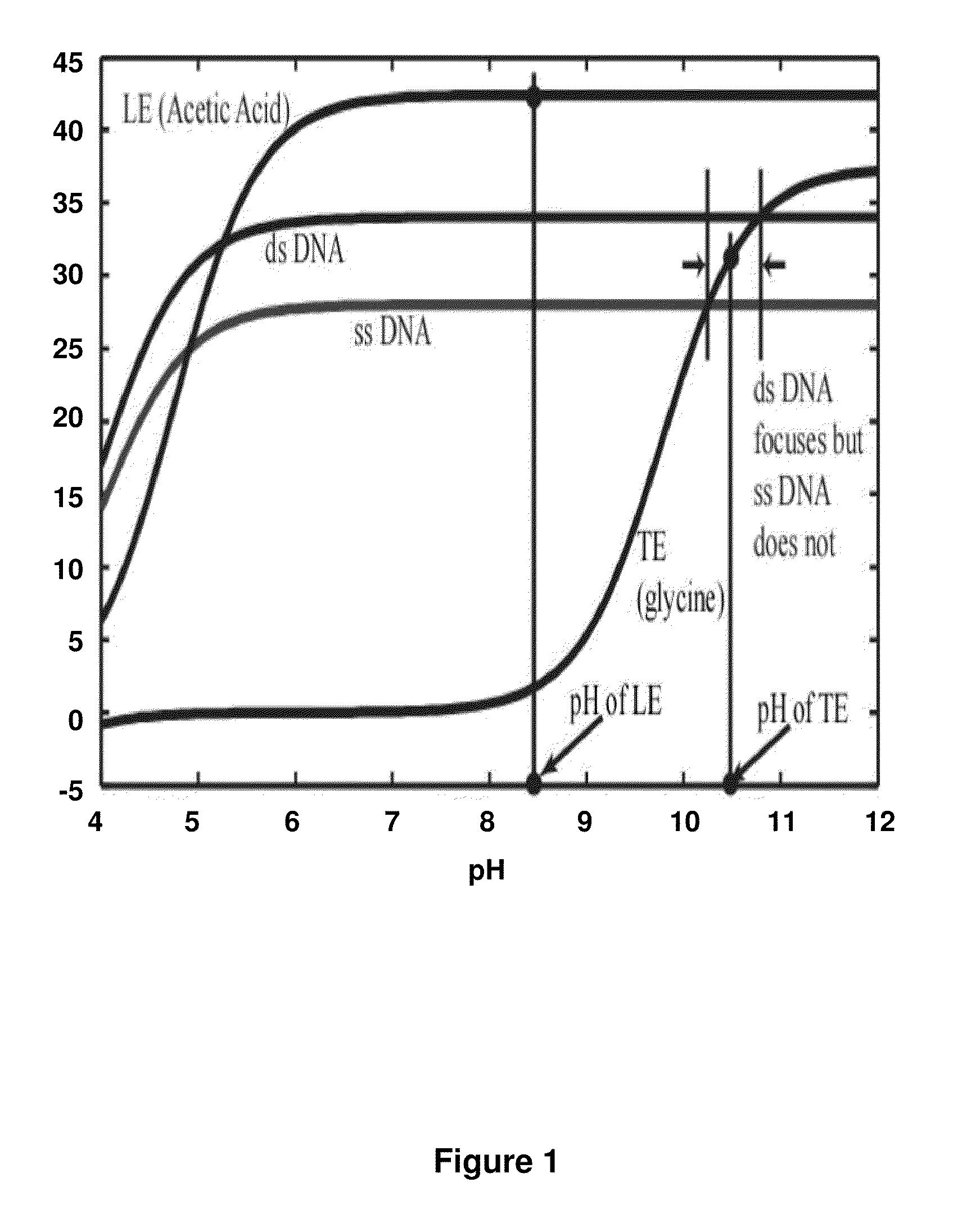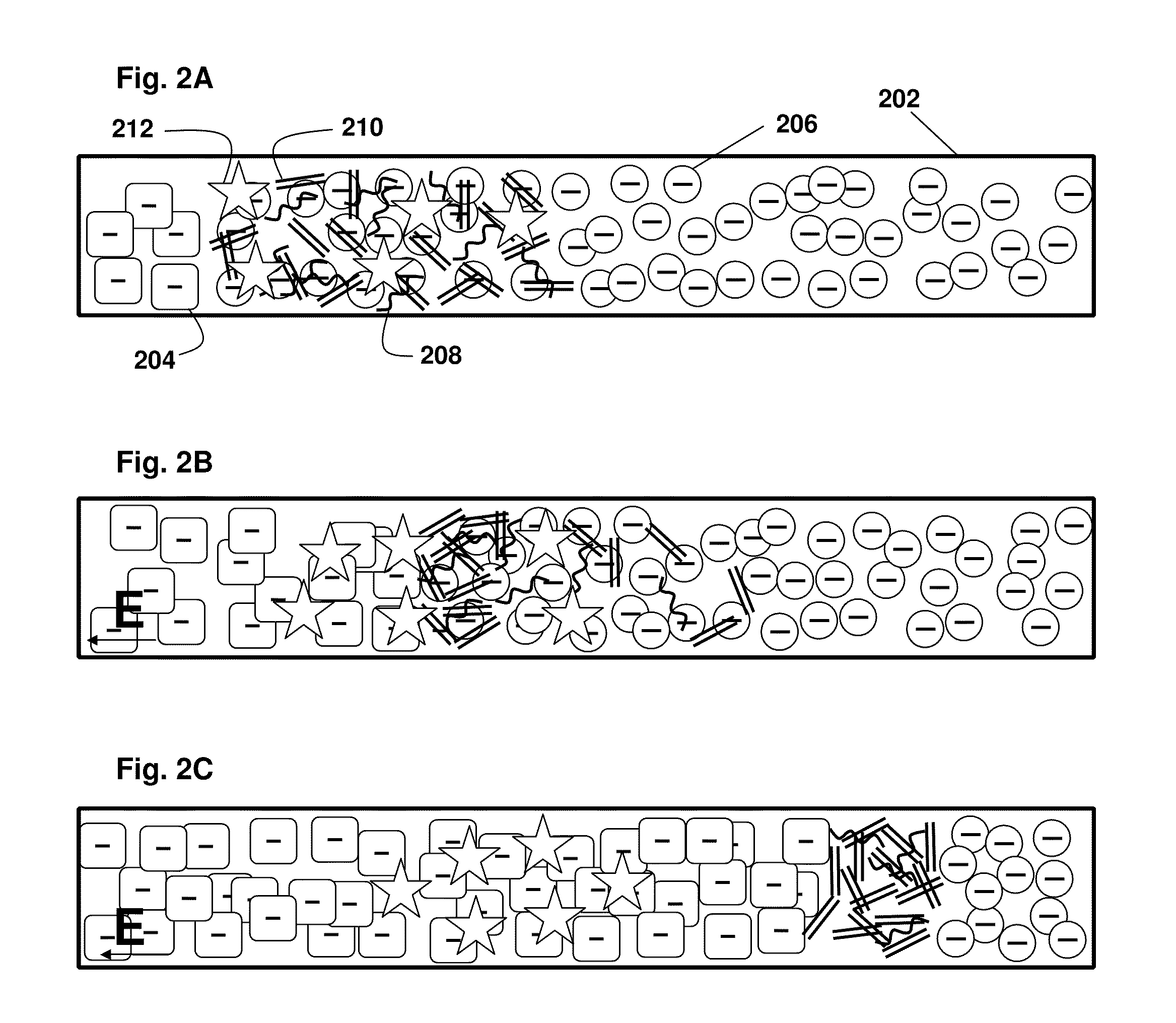Isotachophoretic Focusing of Nucleic Acids
a technology of isotachophoretic focusing and nucleic acids, applied in the direction of fluid pressure measurement, liquid/fluent solid measurement, peptide, etc., can solve the problems of limiting the capability of many devices, affecting the ability of many devices, and a large amount of sample preparation,
- Summary
- Abstract
- Description
- Claims
- Application Information
AI Technical Summary
Benefits of technology
Problems solved by technology
Method used
Image
Examples
example 1
Purification of Nucleic Acids from Whole Blood Using Isotachophoresis
[0100]As shown in FIG. 2A-C, the present principles of nucleic acid purification from complex samples involve the use of an LE (circles 206) and TE (squares 204) in a microchannel 202. The sample initially comprises a plug of mixed components, shown as DNA (double lines 210), RNA (curved lines 208) (collectively “NA”) and proteins and other content (stars 212). In the middle panel FIG. 2B, the initial separation of nucleic acids by moving in to the LE is shown. In the bottom panel FIG. 2C, the NA are shown between the LE and TE, while other components remain in the TE. That is, LE and TE are selected with mobilities, respectively, larger and smaller than NA. The TE needs to have larger mobility than proteins (and other contents) present in blood lysate. We inject a finite plug of lysate between TE and LE. Upon application of an electric field, NA focus between LE and TE, while proteins cannot focus as they travel s...
example 2
Characterization of Extraction Efficiency of Purified DNA Produced
[0114]In purification procedure for DNA, there are at least two extraction efficiencies of interest: the fraction of DNA purified and focused via ITP from the amount injected into the channel and the amount of DNA extracted from the chip and delivered to PCR versus the amount of DNA in the lysate dispensed into the chip. To characterize the former, we applied our technique to a solution of λ-DNA of known concentration. We injected 10 pg of λ-DNA on-chip and performed the ITP purification as described in Example 1. We determined the amount of focused DNA by quantifying SYBR Green I fluorescence and comparing it to the standard. We measured the mean fraction of extracted DNA (v. amount injected into the channel) as 1.03±0.06 (N=3). This approximately complete extraction is at least as good as traditional extraction methods (e.g., QIAGEN kits) and state-of-the-art microsolid phase extraction devices 6.We estimate that we...
example 3
Localization and Extraction of ITP-purified DNA
[0115]We track the location of the focused NA ITP zone by either monitoring ionic current or by fluorescence visualization. FIG. 5 shows a measured current trace obtained from a constant voltage ITP extraction experiment where the sample is a solution containing 7 ng.; L-1 of lambda λ-DNA. We acquired the current trace by interfacing the sourcemeter with MATLAB using a GPIB card (National Instruments, TX). The current decreases monotonically as the ITP interface advances within the channel, as the relatively low conductivity TE replaces the high conductivity LE. At the moment where the current reaches a plateau (here near t=260 s), the purification channel is entirely filled with TE and the ITP interface has reached the anode reservoir. Above the current plot (5A), is an actual image of focused DNA in the microchannel (with a superposed schematic of walls). FIG. 5B shows drawings of actual fluorescence images corresponding to the same e...
PUM
| Property | Measurement | Unit |
|---|---|---|
| Time | aaaaa | aaaaa |
| Time | aaaaa | aaaaa |
| Concentration | aaaaa | aaaaa |
Abstract
Description
Claims
Application Information
 Login to View More
Login to View More - R&D
- Intellectual Property
- Life Sciences
- Materials
- Tech Scout
- Unparalleled Data Quality
- Higher Quality Content
- 60% Fewer Hallucinations
Browse by: Latest US Patents, China's latest patents, Technical Efficacy Thesaurus, Application Domain, Technology Topic, Popular Technical Reports.
© 2025 PatSnap. All rights reserved.Legal|Privacy policy|Modern Slavery Act Transparency Statement|Sitemap|About US| Contact US: help@patsnap.com



